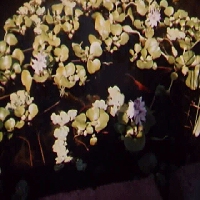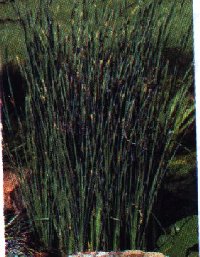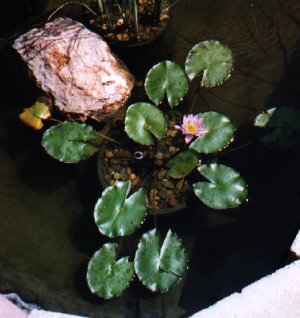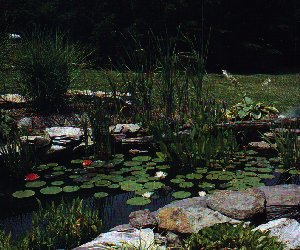| LinkExchange Member | Free Home Pages at GeoCities |
A Variety Of Aquatic Plants
 |
| 
Pictured above are water hyacinth and cattails
There are a variety of hardy aquatic plants for your pond available. General cultivating basics include:
Sun: The more sun the better. Container gardens prefer early afternoon shade.
Quiet Water: Avoid water motion close to the plants.
Water Depth: 0-18 inches from top of soil to water surface.
Heavy Garden Topsoil: Do not use commercial potting mixes, avoid anything with insecticides or herbicides.
Equipment: Variety of planting containers (pans, pails and/or tubs).
During the spring and summer months....
1. Fertilize twice monthly.
2. Prune old leaves and blossoms.
3. Divide in the spring, every 2 or 3 years in zones 3 to 8, every year in zones 9 to 11.
During the winter months....
1. Stop fertilizing.
2. Prune dead leaves and stems.
3. Lower hardy water lilies, lotus, and hardy bog plants to pool bottom after killing frost. In Minnesota, we store the plants in picnic coolers. First, place the plants in the bottom of the cooler (cut the plants back after they have dried). Secondly, put a layer of newspaper over the top of the plants and put just enough water on the paper to make it damp. The picnic coolers can then be stored in a cool dark place until spring (occasionally check the dampness of the newsprint, adding water if necessary).

This is the first lily we put in our pond. We drove 45 miles to meet a gal in Hutchinson. She brought along pictures of the naturalistic pond she and her husband had built the year before. We hadn't been able to find much information about ponds in Minnesota; so it was wonderful to find someone who actually had some answers.
In late May, we take the plants out to the deck and put them in the shade, slowly introducing them to sunlight over a two week period. The pond should be filled about two weeks prior to adding the plants or fish.
4. If ice forms against the planting containers, remove them to your cellar, with pruned plants in place.
5. Keep cool (40 degrees) and moist in dark plastic bags till spring.
6. Tropicals will not survive heavy frost and are considered annuals in climates with repeated frosts. In semi-tropical climates cover pool with canvas, plastic or fiberglass during rare frost.

The lavender lily we added last summer. The flowers were lovely, however, they blooms lasted only a day or two. The flowers close and night and will only open up in full sun.
To plant water lilies, follow this procedure:
1. Gently hose off lilies to remove foreign matter and keep wet while planting.
2. Fill your container 1/3 full of soil.
3. Add fertilizer and add more soil to fill container 1/2 full.
4. Position lily and carefully add soil around roots and tamp down. Keep growing crown (at top of root formation) free of soil.
5. Thoroughly saturate soil with water.
6. Lower potted lily into pool to a depth of 6 to 18 inches of water over soil surface, making sure at least 2 to 3 pads rest on the water's surface.
7. Lilies require 2 to 3 weeks adjustment after planting before new growth resumes.
8. Soil and fertilizer may be increased or decreased for larger or smaller growth.
9. Fertilize your lilies once or twice a month during the growing season.

the above pond shows a wide variety of pond plants.
Water lilies are the most dramatic plants you can add to your water garden. Whether day or night, the lilies evoke romance and glamour. They give more blooms, more fragrance, more petals and they can take the heat. Hardy waterlilies will bloom well into the fall, until the first heavy, killing frost. As the temperatures cool late in the summer and early fall, the lilies will 'numb' and not be able to close.
The Lotus is the most spectacular of the lilies. Incredible blossoms and leaves, standing 1-7 feet out of the water, permeate the garden with their heady perfume. After the third day of bloom, the petals fall, revealing another development. - the strong and distinctive seed pod. Lotus take a year or two to become established. They send up aerial leaves and blossoms open eary in the morning and close in mid-afternoon. They are winter hardy perennials in zones 4-10 (except Pacific Northwest and Alaska); require 5-6 hours of direct sunlight; require still wate 2 to 4 inches above soil; blossom for 6-8 weeks during mid-summer; require 1 full year to become established; require at least 20 quarts of heavy top soil. They are well worth the special attention.....as all the oohs and ahs will attest.
Depending on your design and space requirements, the addition of Iris' near your pond can add that special touch. Iris prefer a slightly acid soil with some humus. They clump nicely and can be propogated by root division every few years. Blooming season is earlier in warmer zones, later in cooler zones. They tolerate Bog or wet soil, and prefer full sun at least 5 to 6 hours a day.
No pond would be complete without shallow wateror marginal bog plants. These are the endless array of plants found along the water's edge and in the bog. The sizes, shapes, textures and colors are boundless. For greatest effect, you can mass together 2 or 3 different varieties.
Our cattails spend their winter in a picnic cooler, however, if you have a sunny spot in your home, simply bring your non-flowering tropical bogs out of the pond, container and all. Place them in decorative pots inside your house. A bright , sunlit room is best. Keep them well watered. They will reward you with lush tropical growth all winter long, and keep your dry winter home slightly humidified.
Narrow Leaved Vertical Varieties Include:
Dwarf Bamboo: Excellent for low screening or borders.
Cattail: Tall plant good for accent or screening.
Narrow Leafed Cattail: Graceful leaves attractive swaying in a breeze.
Chinese Water Chestnut: Graceful cylindrical stems, produces tuber used in oriental cooking.
Horsetail: Jointed-stem structure, also known as scouring rush.
Red Stemmed Sagittaria: Bold, red stems support flaring green leaves.
Sagittaria: Bright green grasslike leaves. Bears tiny white flowers.
Spike Rush: Club-line light brown flower on narrow quill shaped leaves. Low border plant excellent in bogs.
Sweetflag: Iris-like leaves have strong, sweet aroma when crushed.
Variegated Sweetflag: Boldly variegated foliage makes a distinct accent in your water garden.
Broad Leafed Vertical Varieties Include:
Arrowhead: Three petaled, white flowers are attractive on this distinctively foliaged plant.
Water Arum: Glossy arrowhead shaped leaves.
Chameleon Plant: Multi-colored leaves of white, green, red, maroon. Excellent ground cover or water plant.
Golden Club: White spike tipped with brilliant yellow.
Lizard's Tail: Fragrant flowers produced on long spikes. Somewhat heart shaped leaves.
Pickerel Rush: Excellent clumping plant with spike flowers. Continuous bloom and can be used as cut flowers.
Thalia: Tall, broad-leafed plant features graceful flowering stems held well above its 3 to 4 foot foliage.
The following plants are surface covering varieties:
Aquatic Mint: Luscious mint fragrance. Forms a lush edge cover.
Creeping Jenny: Versatile ground cover, pond's edge cover or use with upright bogs. Occasional blooms add seasonal interest to its charming foliage.
Floating Heart: Five petaled yellow flowers held slightly above water surface. 3 inch green and maroon variegated leaves.
Parrots Feather: Lush lime green foliage trails along the waters's surface. Good for spawning.
Water Clover: Four leaf clover leaves to 3 inches across. Brown/yellow accents.
The Bog Plants below are all tropical bog plants and make sensational houseplants all winter.
Bog Lily: Long petaled, white flowers are very fragrant.
Water Canna: Tropical cannas suited to aquatic gardens. The blooms come in red, yellow or orange spots.
Longwood Canna: Exciting variety featuring slender leaves. Red, yellow or salmon blossoms.
Variegated Canna: Large green leaves boldly striped with yellow. Bright orange flowers create dramatic accent.
Ludwegia: Charming square leaves in unique swirling pattern.
Dwarf Papyrus: Tufts of foliage are borne atop tall stems. Excellent accent plant.
Egyptian Paper Reed: Giant plants provide exotic accent to the tamest of gardens.
Water Poppy: 3-petaled yellow flowers about 2 inches across are held slightly above the water's surface.
Spider Lily: narrow petaled, large fragrant flowers are outstanding.
Variegated Spider Lily: Delightful flower with boldly striped foliage.
Black Princess Taro: Dark green foliage overlaid with velvety black. Bold plant. Prefers some shade.
Green Taro: Grown for its lush elephant ear leaves.
Variegated Taro: Striking ivory mottling on lush green leaves.
Violet Stemmed Taro: Violet stemmed version of the exotic green taro.
Red Stemmed Thalia: Bold leaves are supported on red stems. Flowering spikes are up to 10 feet high.
Umbrella Palm: Whorls of spiked foliage give lively distinctive shape.
Yellow SnowFlake: Bright yellow flowers with brown leaves patterned with green veins.
White snowFlake: Produces 3/4 inch fragrant white flowers in abundance with floating pads.
Below, you will find a site index along with other homesteading links
| View Guestbook | |||
Last Updated July 10, 1998



